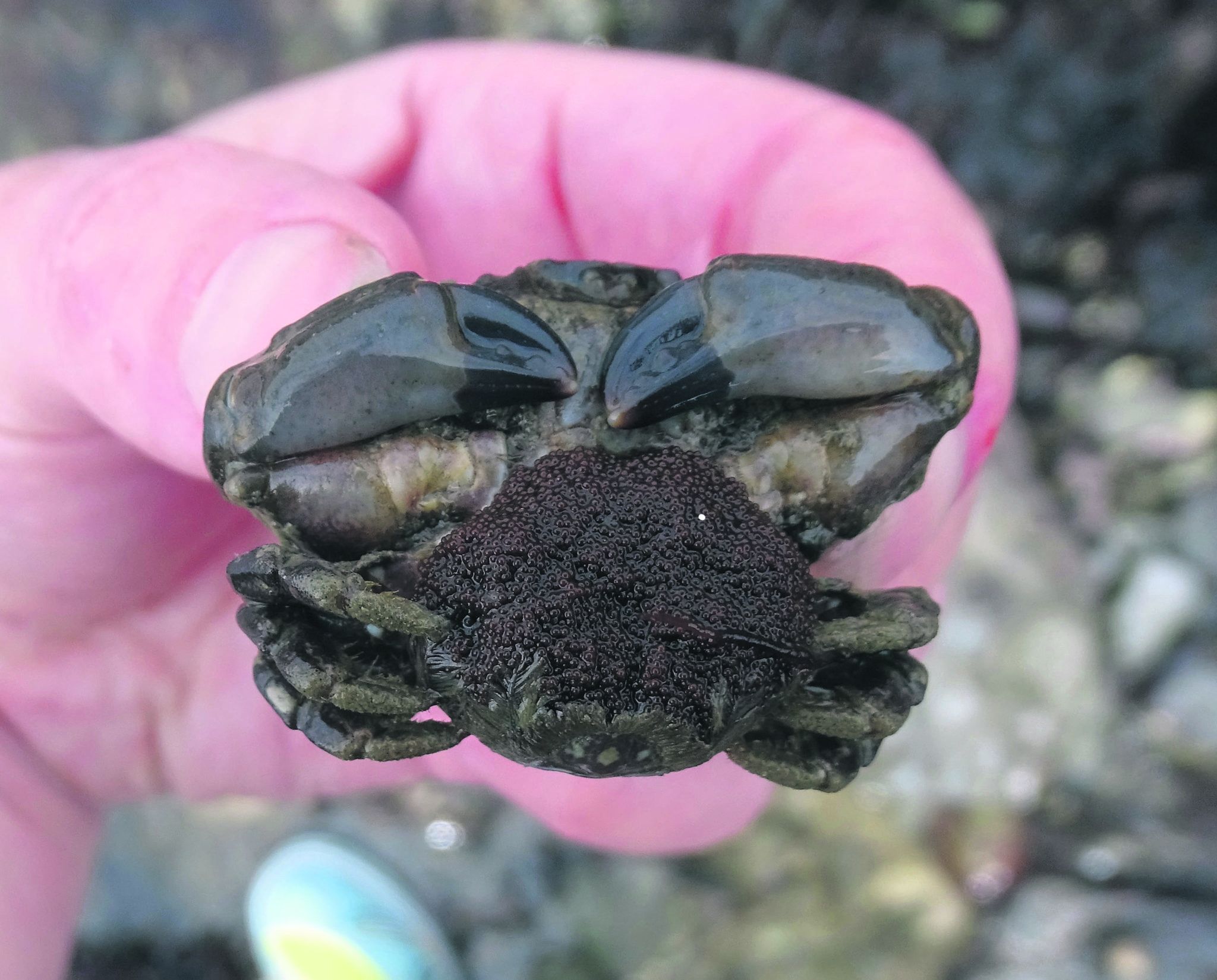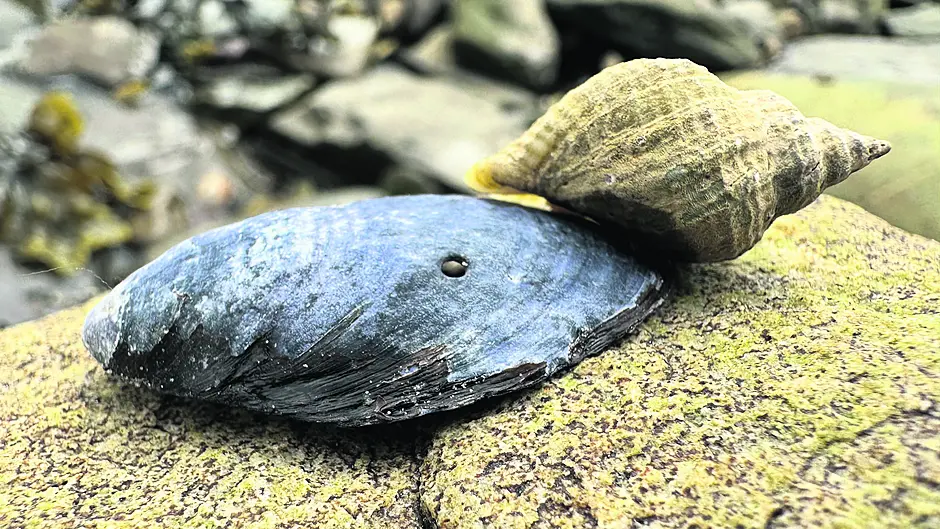BY ANN HAIGH
I’M sure it is no surprise to read that I love our coastline and the fascinating marine life that our rugged shore is home to. Therefore, when the Ballydonut (Ballydehob’s doughnut economics group) asked me to join students and teachers from Schull Community College on a seashore biodiversity outing on Cadogan’s Strand, of course I said yes!
You might wonder what exactly baked goods have to do with nature, but the Ballydonut (part of the West Cork Doughnut Economy Network) seeks to develop sustainable practices that contribute to a thriving society and a healthy ecosystem.
Moze Jacobs, the group’s spokesperson, explains that the name denotes the shape of the ‘safe space for humanity’ that is the intended goal of ‘ticking all the boxes’ required to keep humans and the planet flourishing and that biodiversity is an essential component in this.
 Montagu’s crab with eggs.
Montagu’s crab with eggs.
Rocky Shore BioBlitz
The aim of the outing was to help the students begin to understand how the vast
array of marine creatures interact with each other and their environment. I have also been hearing the word ‘bioblitz’ a lot recently, so we decided that it would be fun and worthwhile for us to take part in one. The bioblitz idea challenges people to spot as many different species as possible. In this instance we took part in a citizen science initiative being run by Explore Your Shore, which is the marine arm of the National Biodiversity
Data Centre. With the help of the teachers and students, we scoured Cadogan’s strand and managed to find 70 unique seashore species.
These were all photographed and uploaded to the
National Biodiversity Data Centre records, which will serve to inform conservation science and planning. A great result for a morning spent enjoying nature.
Highlights
The fish we found in the intertidal area were amazing creatures, adapted to live in a zone that is sometimes underwater and sometimes exposed. The students quickly found their first shanny, also known as the common blenny. This fish also has a nickname, which is the ‘sea frog’ due to their ability to survive out of water at low tide. Next, there were cries of wonder as a butterfish was discovered. This creature looks like an eel and gets their name from their slippery and slimy skin, like butter, making them very hard to catch. This was indeed the case when the students tried. Butterfish are easily identifiable by their eel-like look and black spots on their back.
Next up was a worm pipefish which is closely related to the seahorse. This gave the opportunity to discuss the quirks of parental care in the intertidal area, with the male pipefish, as we were able to see, carrying the female’s eggs on their underbellies until they hatch. We even found a female Montagu’s crab with her eggs carried on her underside, held in place by an abdominal flap, which is termed as being in ‘berry.’
Shells
There was no shortage of all the various seashells; whelks, winkles, cockles, scallops and limpets for few examples. The students were amazed to learn that limpets, those very familiar and seemingly stationary conical shells that we usually observe clamped firmly onto the rocks, can actually move. They fool you into thinking they are stationary, but beneath that shell is a soft bodied snail which springs to life once the tide comes in. As they travel, slowly, they use a specialised tongue with teeth on it, known as a radula, to feed on algae that they scrape off the rocks. Amazingly, the material that the tongue-teeth are made of is the hardest known biological material and is much studied by scientists. If you look closely, it is sometimes possible to see patterns on the rock which have been made by the scraping of the limpet’s teeth. Limpets keep to the same location on the rocks and once the tide starts to go out again, they return to this ‘home.’ They recognise the location as they wear away an indent that fits their shell’s shape, known as the home scar.
Gruesome stories
No biodiversity outing with a school should go without a tale of gore. The students reminded me of this nicely when an empty blue mussel shell with a tiny and perfectly circular hole in its shell was found.
Like a seashore episode of CSI Schull (Crime Scene Investigation), we were able to determine what had killed the blue mussel – a dog whelk. Dog whelks are gastropod molluscs (sea snails) and are related to land snails. However, unlike your typical land snails, dog whelks are voracious carnivores and prey on other sea creatures like mussels and barnacles.
Mussels are clever and tightly close their shells to defend against predators but the dog whelk has ways around this. It mounts the mussel and bores a hole in its shell using the rasping teeth on its radula. The rasping teeth are assisted by chemical secretions which soften the shell.
Once the whelk has penetrated the shell, it sticks in its straw-like proboscis and injects a cocktail of paralysing chemicals and digestive enzymes to immobilise and digest the mussel. Once the mussel is partly digested, the whelk sucks out this mussel soup.
Future outings
While this was a successful bioblitz outing in terms of the number of species, there were still a few likely characters missing that we should probably have spotted. The consensus with Schull Community College is that we will just have to go back again. On the list for spotting next time are sea slugs, hermit crabs, starfish and some of our common marine worms. If you are visiting Cadogan’s strand yourself, perhaps you can have a look and see if you can beat us to it!
• Ann Haigh MVB MSc MRCVS is a Skibbereen resident, a mum-of-two and a veterinarian with a masters in wildlife health and conservation and she is passionate about biodiversity and nature.









